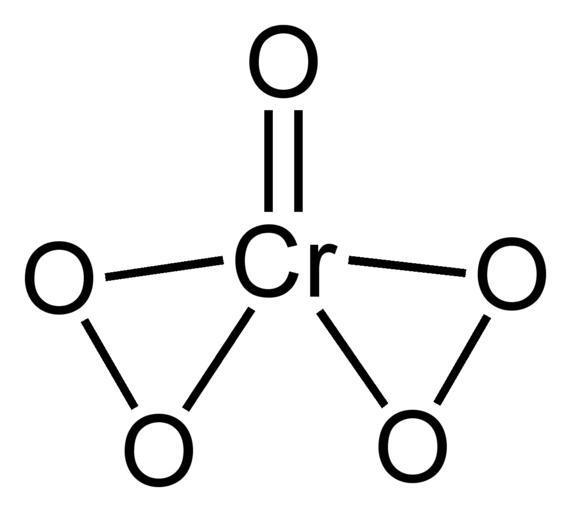
How many peroxy linkages are present in $ Cr{O_5} $ ?
Answer
509.4k+ views
Hint :Peroxide refers to any chemical compound in which two oxygen atoms are joined by a single covalent bond. Several organic and inorganic peroxides, as well as other oxygen molecules, are also used as bleaching agents. Peroxide linking is essentially an O - O bond.
Complete Step By Step Answer:
Peroxides are a class of compounds with the formula ROOR, where R stands for any element. The peroxide group, also known as the peroxo group, is the OO group of a peroxide. The nomenclature is a little erratic.
Hydrogen peroxide (), also known as "peroxide," is the most common peroxide. It's sold as water-based solutions in varying concentrations. Chemical peroxides are also well-known.
The addition of acidified hydrogen peroxide solutions to metal chromates or dichromates, such as sodium chromate or potassium dichromate, produces chromium(VI) peroxide. As chromium(VI) peroxide forms, the normally yellow chromates or orange dichromates turn dark blue. Chromium peroxide and water are formed when chromate or dichromate reacts with hydrogen peroxide and an acid.
$ {\text{CrO}}_4^{2 - } + 2{{\text{H}}_2}{{\text{O}}_2} + 2{{\text{H}}^ + } \to {\text{Cr}}{{\text{O}}_5} + 3{{\text{H}}_2}{\text{O}} $

The unstable compound chromium (VI) peroxide, also known as chromium oxide peroxide, has the formula $ Cr{O_5} $ . There are five oxygen atoms per chromium atom in this compound, due to one oxo ligand and two peroxo ligands.
Peroxide linking is essentially an O - O bond
Hence the number of peroxo linkage in $ Cr{O_5} $ is 2.
Note :
To prevent decomposition, chromium(VI) oxide peroxide can be stabilised in water-insoluble organic solvents like diethyl ether, butan-1-ol, or amyl acetate by layering the organic solvent over the chromate/dichromate solution and shaking before applying hydrogen peroxide. The chromium(VI) peroxide (unstable in its newly formed aqueous phase) is dissolved in the immiscible organic solvent in this manner. It can be seen over a much longer period of time in this state.
Complete Step By Step Answer:
Peroxides are a class of compounds with the formula ROOR, where R stands for any element. The peroxide group, also known as the peroxo group, is the OO group of a peroxide. The nomenclature is a little erratic.
Hydrogen peroxide (), also known as "peroxide," is the most common peroxide. It's sold as water-based solutions in varying concentrations. Chemical peroxides are also well-known.
The addition of acidified hydrogen peroxide solutions to metal chromates or dichromates, such as sodium chromate or potassium dichromate, produces chromium(VI) peroxide. As chromium(VI) peroxide forms, the normally yellow chromates or orange dichromates turn dark blue. Chromium peroxide and water are formed when chromate or dichromate reacts with hydrogen peroxide and an acid.
$ {\text{CrO}}_4^{2 - } + 2{{\text{H}}_2}{{\text{O}}_2} + 2{{\text{H}}^ + } \to {\text{Cr}}{{\text{O}}_5} + 3{{\text{H}}_2}{\text{O}} $

The unstable compound chromium (VI) peroxide, also known as chromium oxide peroxide, has the formula $ Cr{O_5} $ . There are five oxygen atoms per chromium atom in this compound, due to one oxo ligand and two peroxo ligands.
Peroxide linking is essentially an O - O bond
Hence the number of peroxo linkage in $ Cr{O_5} $ is 2.
Note :
To prevent decomposition, chromium(VI) oxide peroxide can be stabilised in water-insoluble organic solvents like diethyl ether, butan-1-ol, or amyl acetate by layering the organic solvent over the chromate/dichromate solution and shaking before applying hydrogen peroxide. The chromium(VI) peroxide (unstable in its newly formed aqueous phase) is dissolved in the immiscible organic solvent in this manner. It can be seen over a much longer period of time in this state.
Recently Updated Pages
The number of solutions in x in 02pi for which sqrt class 12 maths CBSE

Write any two methods of preparation of phenol Give class 12 chemistry CBSE

Differentiate between action potential and resting class 12 biology CBSE

Two plane mirrors arranged at right angles to each class 12 physics CBSE

Which of the following molecules is are chiral A I class 12 chemistry CBSE

Name different types of neurons and give one function class 12 biology CBSE

Trending doubts
One Metric ton is equal to kg A 10000 B 1000 C 100 class 11 physics CBSE

Explain zero factorial class 11 maths CBSE

What is 1s 2s 2p 3s 3p class 11 chemistry CBSE

Discuss the various forms of bacteria class 11 biology CBSE

State the laws of reflection of light

An example of chemosynthetic bacteria is A E coli B class 11 biology CBSE




